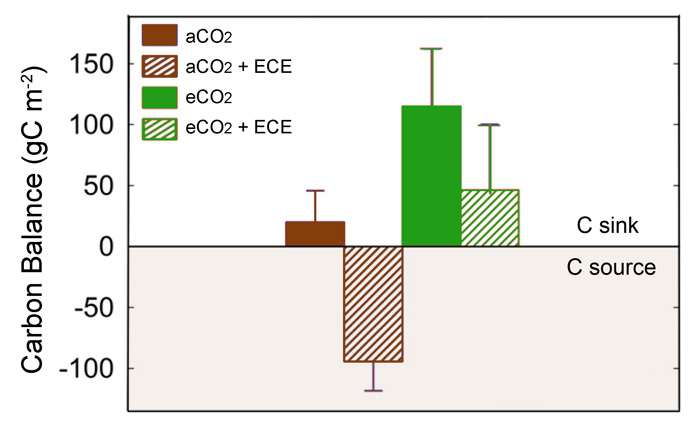| Follow @co2science |
Paper Reviewed
Roy, J., Picon-Cochard, C., Augusti, A., Benot, M.-L., Thiery, L., Darsonville, O., Landais, D., Piel, C., Defossez, M., Devidal, S., Escape, C., Ravel, O., Fromin, N., Volaire, F., Milcu, A., Bahn, M. and Soussana, J.-F. 2016. Elevated CO2 maintains grassland net carbon uptake under a future heat and drought extreme. Proceedings of the National Academy of Sciences USA 113: 6224-6229.
Introducing their study, Roy et al. (2016) write that extreme climatic events, or ECEs such as droughts and heat waves, "are predicted to increase in intensity and frequency and impact the terrestrial carbon balance," noting, however, that we lack direct experimental evidence of how the net carbon uptake of ecosystems may be affected by ECEs under future elevated atmospheric CO2 concentrations (eCO2).
Consequently, and to gain that needed knowledge, the 17 researchers used the Montpellier CNRS Ecotron facility to simulate eCO2 and extreme co-occurring heat and drought events as projected for the 2050s, the effects of which they analyzed on the ecosystem-level for both carbon and water fluxes in the Ecotron's C3 grassland. And what did this work reveal?
Roy et al. report discovering that "eCO2 not only slows down the decline of ecosystem carbon uptake during the ECE but also enhances its recovery after the ECE, as mediated by increases of root growth and plant nitrogen uptake induced by the ECE." And these findings indicate, in their words, that "in the predicted near-future climate, eCO2 could mitigate the effects of extreme droughts and heat waves on ecosystem net carbon uptake" and change the carbon balance during such events from an ecosystem source to a sink (see figure below), which is extremely good news for the entire biosphere.

Figure 1. Full growing season (April 26-November 3) ecosystem carbon (C) balance (>0 = sink; <0 = source) as affected by the CO2 and ECE treatments described above. Adapted from Roy et al. (2016).




